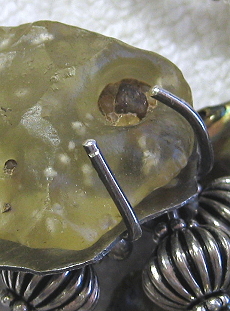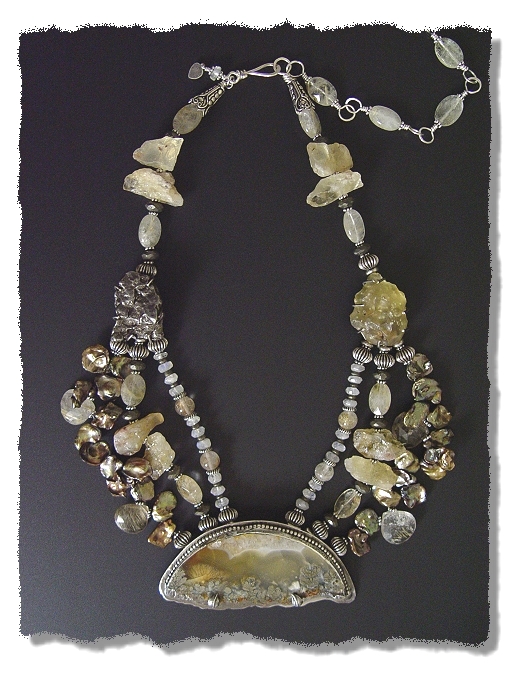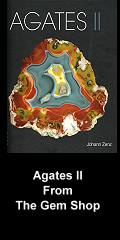Leigh Becker (Eidos) has a remarkable eye for finding beautiful images in stone. He appreciates Mother Nature's thoughts and does things like this: cutting a crescent of Nipomo plume and leaving the natural agate edge untouched, allowing the sagenite (yellowish plume and white plume) and marcasite (metalic plumes) sea creatures to appear to grow out of the natural surface. Volume II of the monumental Agates series mentions the Nipomo area which is famous for its sagenite agates and notes, "A vein with marcasite plumes and sagenite was dug in 1942 by Mr. & Mrs. Bowser of Santa Barbara, California." The accompanying image which includes the same rough crust as this stone is labeled "Famous."
This stone is a primordial underwater garden, but also a translucent jellyfish. Since "jellyfish" is a rather more amusing name that's what I called the necklace but of course you are free to rename it if you find the idea of wearing a jellyfish less than appealing! The raw edge of the agate is echoed in a thin edging of reticulating silver, just for fun. Reticulating silver has a slightly higher copper content than sterling and the fascinating property of forming complex ridges and valleys after repeated heating and pickling.
When I saw the stone I immediately knew it wanted a Campo del Cielo meteorite to go with it, so set about finding a suitable one. (Who knows why these things make sense to me.) These interesting iron meteorites are from a crater in Argentina. Their composition includes traces of nickel and cobalt so I set this one with a full sterling backing to prevent any problems for people with nickel allergies. (I am one, I have worn this necklace without any problem.) It is thought to have hit 4,000 to 5,000 years ago (by carbon dating the charred wood underneath it) and although it was "discovered" by Westerners in 1576, the location of the crater was apparently well known to the indigenous people who used the iron for weapons and who knew it had fallen from the sky. The much wiser Spaniards of course "knew" it did not fall from the sky. HA! Think about the fact that the indigenous culture in the region had an accurate historical memory dating back at least 5,000 years. I have dilated before about how much has been lost because of the arrogance of the invaders. Anyway, according to Wiki (the article is well worth reading and includes intrigue!), to date more than 100 tonnes (a metric tonne is 2205 lbs) have been recovered, fortunately including fascinating small fragments like this with extraordinary surfaces.
In searching for the meteorite, I discovered yellow tektites. What a find!!! Tektites, as you are undoubtedly aware, are glass of terrestrial origin formed when a meteorite strikes the earth... or are they? There are opposing theories, including the "volcanic moon ejecta" theory. However, in this particular case, a HUGE associated crater has been found. Called the Kebira Crater, you can fly to see it in Google Earth at 24°40'23.66"N, 24°57'32.03"E. This and much more fascinating information about these tektites can be found here but please come back after you've read about them!!! Common tektite tests include the observation that the "[tektite] glass is totally free of inclusions or phenocrysts. If you can see any tiny crystals or breccia fragments or pebbles in the glass, it is not a tektite... The only exception to this rule is in the case of Libyan Desert Glass which may contain devitrification spherulites of white cristobalite." Hmmm. This tektite contains an approximately 1/4" golden brown pebble as well as the spherulites. When you examine it closely, however, it is clear that the pebble is not fully encapsulated but rather was captured as the glass was falling back and cooling.
The only remaining issue in making this piece was... what beads coordinate with Nipomo plume, marcasite, meteorite and tektite? I hope you will like the selection! The books below discuss the metaphysical properties of the stones in this necklace as well as the geological and artistic ones! Please order the primordial jellyfish garden necklace and ponder Mother Nature's gifts.





